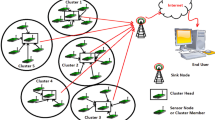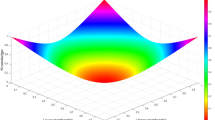Abstract
The efficient management of energy in wireless sensor networks (WSNs) is a primary concern among researchers. Clustering algorithms serve as a crucial technique to address this issue. However, the initial uncertainties in both measuring the WSN’s values and in node localization due to GPS lead to secondary uncertainties like residual energy of nodes, cluster centrality, and distance from the cluster to the base station in the higher layers of WSNs. In this study, we have incorporated five improvements to our previous algorithm “FSCVG: A Fuzzy Semi‑Distributed Clustering Using Virtual Grids in WSN”. Firstly, we have discussed and classified uncertainties into two categories: primary uncertainties and secondary uncertainties. Secondly, we have applied a Type-3 fuzzy system to handle secondary uncertainties. Thirdly, we have used an adaptive imaginary grid to generate uneven clusters and balance the load according to the base station location. Fourthly, both decentralized and centralized clustering have applied based on new adaptive imaginary grid updates. Finally, we have determined the threshold level of each cluster proportionally, based on the energy of nodes within the same cluster. The findings of these improvements indicate an increased lifetime of the network concerning comparable methods.





















Similar content being viewed by others
References
Abdulwahid, H. M., & Mishra, A. (2022). Deployment optimization algorithms in wireless sensor networks for smart cities: A systematic mapping study. Sensors, 22(14), 5094. https://doi.org/10.3390/s22145094
Li, Z., Zhang, L., Cai, Y., & Ochiai, H. (2021). Sensor selection for maneuvering target tracking in wireless sensor networks with uncertainty. IEEE Sensors Journal, 22(15), 15071–15081. https://doi.org/10.1109/JSEN.2021.3136546
Dertimanis, V., & Chatzi, E. (2020). Sensor networks in structural health monitoring: From theory to practice. Journal of Sensor and Actuator Networks, 9(4), 47. https://doi.org/10.3390/jsan9040047
Khalifeh, A., Tanash, R., AlQudah, M., & Al-Agtash, S. (2023). Enhancing energy efficiency of IEEE 802.15.4- based industrial wireless sensor networks. Journal of Industrial Information Integration, 33, 100460. https://doi.org/10.1016/J.JII.2023.100460
Adu-Manu, K. S., Engmann, F., Sarfo-Kantanka, G., Baiden, G. E., & Dulemordzi, B. A. (2022). WSN protocols and security challenges for environmental monitoring applications: A survey. J. Sensors, 2022, 1–21. https://doi.org/10.1155/2022/1628537
Vandôme, P., et al. (2023). Making technological innovations accessible to agricultural water management: Design of a low-cost wireless sensor network for drip irrigation monitoring in Tunisia. Smart Agricultural Technology, 4, 100227. https://doi.org/10.1016/j.atech.2023.100227
Rawat, P., & Chauhan, S. (2021). Clustering protocols in wireless sensor network: A survey, classification, issues, and future directions. Computer Science Review, 40, 100396. https://doi.org/10.1016/j.cosrev.2021.100396
Majid, M., Habib, S., Javed, A. R., Rizwan, M., Srivastava, G., Gadekallu, T. R., & Lin, J. C. W. (2022). Applications of wireless sensor networks and internet of things frameworks in the industry revolution 4.0: A systematic literature review. Sensors, 22(6), 2087. https://doi.org/10.3390/s22062087
Sen, S., Sahoo, L., Tiwary, K., Simic, V., & Senapati, T. (2023). Wireless sensor network lifetime extension via K-medoids and MCDM techniques in uncertain environment. Applied Sciences, 13(5), 3196. https://doi.org/10.3390/app13053196
Bhanu, D., & Santhosh, R. (2023). Fuzzy enhanced location aware secure multicast routing protocol for balancing energy and security in wireless sensor network. Wireless Networks. https://doi.org/10.1007/s11276-023-03461-y
Ambareesh, S., Kantharaju, H. C., & Sakthivel, M. (2023). A novel Fuzzy TOPSIS based hybrid jarratt butterfly optimization for optimal routing and cluster head selection in WSN. Peer-to-Peer Networking and Applications, 16(5), 2512–2524. https://doi.org/10.1007/s12083-023-01517-6
Prasad, V. K. H., & Periyasamy, S. (2023). Energy optimization-based clustering protocols in wireless sensor networks and internet of things-survey. Int. J. Distrib. Sens. Networks, 2023, 1–18. https://doi.org/10.1155/2023/1362417
Jubair, A. M., et al. (2021). Optimization of clustering in wireless sensor networks: Techniques and protocols. Applied Sciences, 11(23), 11448. https://doi.org/10.3390/app112311448
Raj, B., Ahmedy, I., Idris, M. Y. I., & Noor, RMd. (2022). A survey on cluster head selection and cluster formation methods in wireless sensor networks. Wireless Communications and Mobile Computing, 2022, 1–53. https://doi.org/10.1155/2022/5322649
Cofta, P., Karatzas, K., & Orłowski, C. (2021). A conceptual model of measurement uncertainty in iot sensor networks. Sensors, 21(5), 1827. https://doi.org/10.3390/s21051827
Mal-Sarkar, S. (2009). Uncertainty Management of Intelligent Feature Selection in Wireless Sensor Networks (Doctoral dissertation, Cleveland State University).
Magruk, A. (2022). The desirable systemic uncertainty in complex IoT sensor networks—General anticipatory foresight perspective. Sensors, 22(5), 1698. https://doi.org/10.3390/s22051698
Boualem, A., Ayaida, M., De Runz, C., & Dahmani, Y. (2021). An evidential approach for area coverage in mobile wireless sensor networks. International Journal of Fuzzy System Applications (IJFSA), 10(3), 30–54. https://doi.org/10.4018/IJFSA.2021070103
Pan, D., & Zhao, L. (2011). Uncertain data cluster based on DBSCAN. In 2011 International Conference on Multimedia Technology (pp. 3781-3784). IEEE.https://doi.org/10.1109/ICMT.2011.6002707.
Banerjee, S., Erçetin, ŞŞ, & Tekin, A. (Eds.). (2014). Chaos Theory in Politics. Springer, Netherlands.
Edla, D. R., Lipare, A., & Parne, S. R. (2023). Load balanced cluster formation to avoid energy hole problem in WSN using fuzzy rule-based system. Wireless Networks, 29(3), 1299–1310. https://doi.org/10.1007/s11276-022-03200-9
Mazinani, A., Mazinani, S. M., & Mirzaie, M. (2019). FMCR-CT: An energy-efficient fuzzy multi cluster-based routing with a constant threshold in wireless sensor network. Alexandria Engineering Journal, 58(1), 127–141. https://doi.org/10.1016/j.aej.2018.12.004
Bagci, H., & Yazici, A. (2010, July). An energy aware fuzzy unequal clustering algorithm for wireless sensor networks. In International conference on fuzzy systems (pp. 1-8). IEEE. https://doi.org/10.1109/FUZZY.2010.5584580.
Sert, S. A., Bagci, H., & Yazici, A. (2015). MOFCA: Multi-objective fuzzy clustering algorithm for wireless sensor networks. Applied Soft Computing, 30, 151–165. https://doi.org/10.1016/j.asoc.2014.11.063
Baranidharan, B., & Santhi, B. J. A. S. C. (2016). DUCF: Distributed load balancing Unequal Clustering in wireless sensor networks using Fuzzy approach. Applied Soft Computing, 40, 495–506. https://doi.org/10.1016/j.asoc.2015.11.044
Mazumdar, N., & Om, H. (2017). Distributed fuzzy logic based energy-aware and coverage preserving unequal clustering algorithm for wireless sensor networks. International Journal of Communication Systems, 30(13), e3283. https://doi.org/10.1002/dac.3283
Balakrishnan, B., & Balachandran, S. (2017). FLECH: Fuzzy logic based energy efficient clustering hierarchy for nonuniform wireless sensor networks. Wireless Communications and Mobile Computing. https://doi.org/10.1155/2017/1214720
Akila, I. S., & Venkatesan, R. (2016). A cognitive multi-hop clustering approach for wireless sensor networks. Wireless Personal Communications, 90, 729–747. https://doi.org/10.1007/s11277-016-3200-5
Mazinani, A., Mazinani, S. M., & Hasanabadi, S. (2021). FSCVG: A fuzzy semi-distributed clustering using virtual grids in WSN. Wireless Personal Communications, 118(2), 1017–1038. https://doi.org/10.1007/s11277-020-08056-w
Agrawal, D., & Pandey, S. (2018). FUCA: Fuzzy-based unequal clustering algorithm to prolong the lifetime of wireless sensor networks. International Journal of Communication Systems, 31(2), e3448. https://doi.org/10.1002/dac.3448
Castillo, O., Castro, J. R., & Melin, P. (2022). Interval type-3 fuzzy systems: theory and design. Springer International Publishing.
Gomide, F. (2003). Uncertain rule-based fuzzy logic systems: introduction and new directions. Fuzzy Sets and Systems, 1(133), 133–135. https://doi.org/10.1016/s0165-0114(02)00359-7
Mendel, J. M. (2017). Uncertain Rule-Based Fuzzy Systems. Springer International Publishing.
Rickard, J. T., Aisbett, J., & Gibbon, G. (2008). Fuzzy Subsethood for Fuzzy Sets of Type-2 and Generalized Type-${n} $. IEEE Transactions on Fuzzy Systems, 17(1), 50–60. https://doi.org/10.1109/TFUZZ.2008.2006369
Liu, Z., Mohammadzadeh, A., Turabieh, H., Mafarja, M., Band, S. S., & Mosavi, A. (2021). A new online learned interval type-3 fuzzy control system for solar energy management systems. IEEE Access, 9, 10498–10508. https://doi.org/10.1109/ACCESS.2021.3049301
“Interval Type-3 Fuzzy Systems: Theory and Design (Studies in Fuzziness and Soft Computing, 418): Castillo, Oscar, Castro, Juan R., Melin, Patricia: 9783030965143: Amazon.com: Books.” https://www.amazon.com/Interval-Type-3-Fuzzy-Systems-Fuzziness/dp/3030965147 (accessed Apr. 25, 2023).
Santhosh Kumar, S. V. N., Palanichamy, Y., Selvi, M., Ganapathy, S., Kannan, A., & Perumal, S. P. (2021). Energy efficient secured K means based unequal fuzzy clustering algorithm for efficient reprogramming in wireless sensor networks. Wireless Networks, 27, 3873–3894. https://doi.org/10.1007/s11276-021-02660-9
Abasikeleş-Turgut, İ. (2020). DiCDU: Distributed clustering with decreased uncovered nodes for WSNs. IET Communications, 14(6), 974–981. https://doi.org/10.1049/iet-com.2019.0629
Abasıkeleş-Turgut, İ, & Altan, G. (2021). A fully distributed energy-aware multi-level clustering and routing for WSN-based IoT. Transactions on Emerging Telecommunications Technologies, 32(12), e4355. https://doi.org/10.1002/ett.4355
Abasıkeleş-Turgut, İ. (2021). Multihop routing with static and distributed clustering in WSNs. Wireless Networks, 27(6), 3797–3809. https://doi.org/10.1007/s11276-021-02683-2
Author information
Authors and Affiliations
Corresponding author
Additional information
Publisher's Note
Springer Nature remains neutral with regard to jurisdictional claims in published maps and institutional affiliations.
Rights and permissions
Springer Nature or its licensor (e.g. a society or other partner) holds exclusive rights to this article under a publishing agreement with the author(s) or other rightsholder(s); author self-archiving of the accepted manuscript version of this article is solely governed by the terms of such publishing agreement and applicable law.
About this article
Cite this article
Mozaffari, M., Mazinani, S.M. & Khazaei, A.A. An energy efficient grid-based clustering algorithm using type-3 fuzzy system in wireless sensor networks. Wireless Netw (2024). https://doi.org/10.1007/s11276-024-03737-x
Accepted:
Published:
DOI: https://doi.org/10.1007/s11276-024-03737-x




